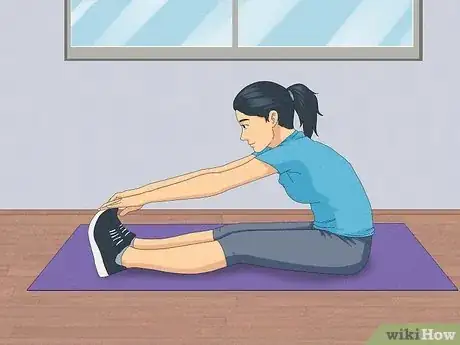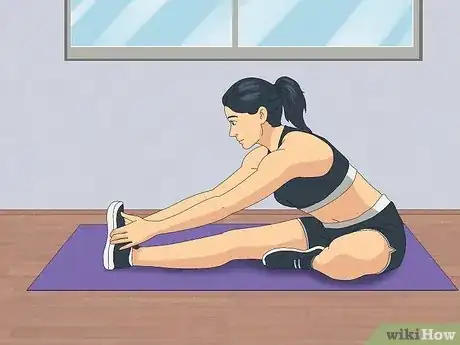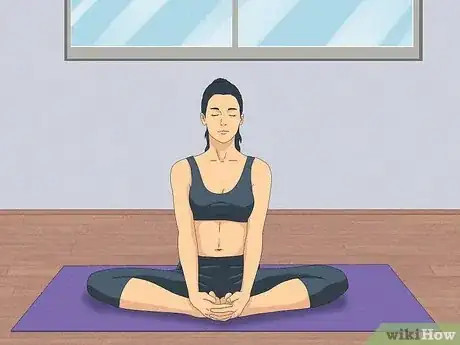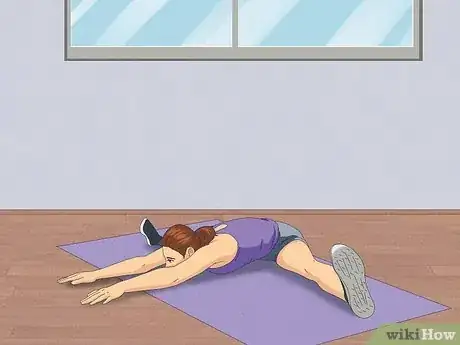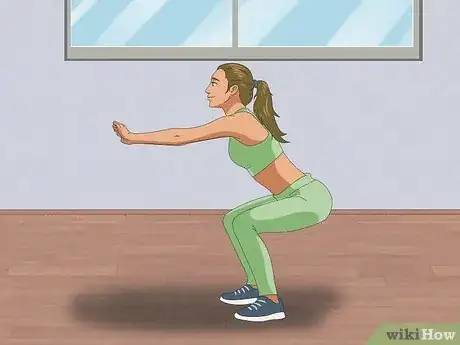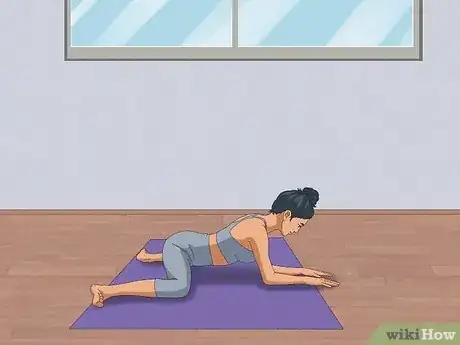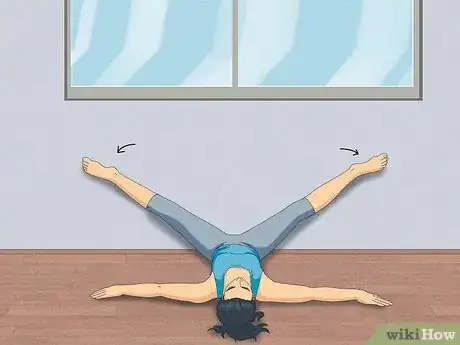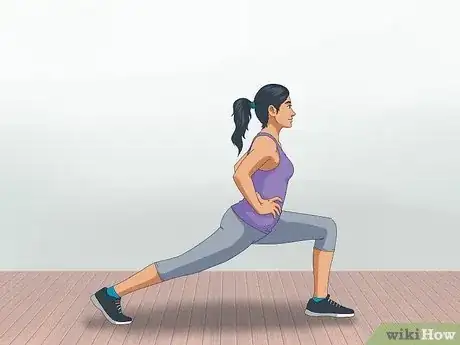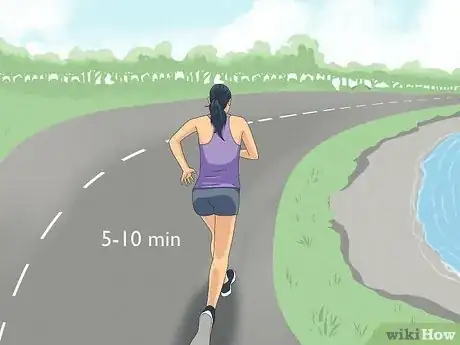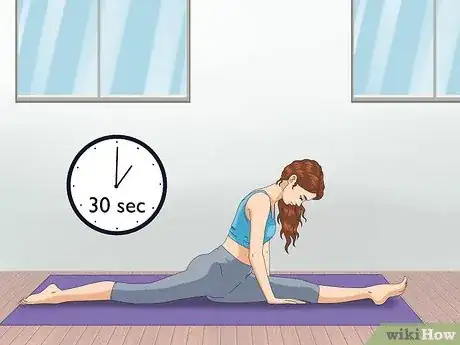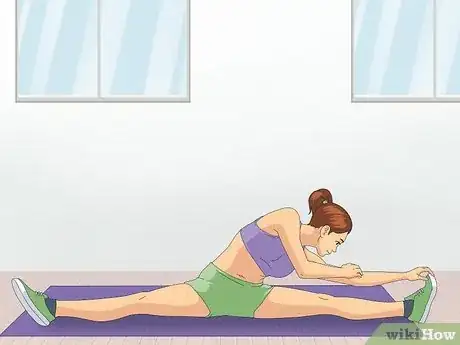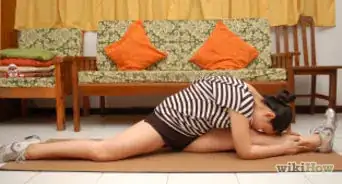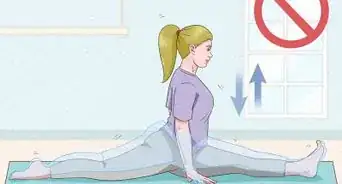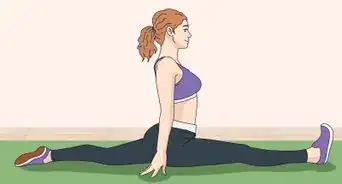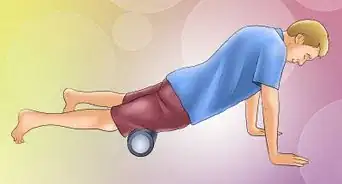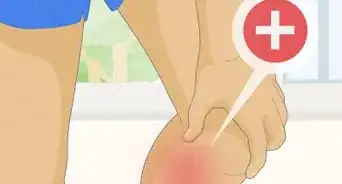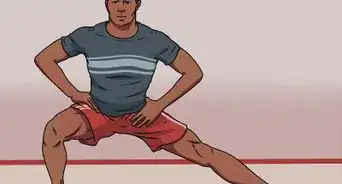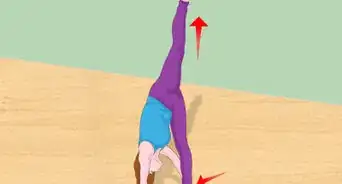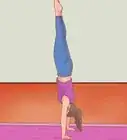This article was co-authored by Greg Maurer. Greg Maurer is a Health & Fitness Specialist and the Vice President of Fitness and Education for Workout Anytime. With over a decade of experience, he specializes in functional training, yoga, pilates, exercise and aging, home exercise programs, and numerous fitness diets. Greg holds a BS in Exercise Physiology from Temple University.
There are 10 references cited in this article, which can be found at the bottom of the page.
wikiHow marks an article as reader-approved once it receives enough positive feedback. This article received 16 testimonials and 90% of readers who voted found it helpful, earning it our reader-approved status.
This article has been viewed 1,686,792 times.
Doing the splits indicates great flexibility. You can perform the splits as part of a gymnastics or dance routine or simply for your own benefit. To prepare for the splits, start by stretching every other day. Incorporate toe-touch stretches into your work-out routine to see an improvement in flexibility. Dynamic stretches, such as wall straddles, will also lengthen your thigh and hip muscles. Getting ready to do the splits will take time, so be patient and pay attention to your body to avoid injuries. Stop stretching immediately if you feel any pain.
Steps
Performing Versions of a Toe-Touch Stretch
-
1Work on a traditional toe-touch. Sit on a mat with your legs straight together in front of you. Bend forward and reach your hands toward your feet. When you touch your feet, gently hold them for 30 seconds. Then slowly roll your upper body back into the upright position. Repeat for as many reps as you like.[1]
- If you cannot reach your feet, hold your hands out as far as you can go.
- If you want more of a challenge, flex your feet outwards and try to touch your toes. Try to make your body as flat as possible.
- Do not force yourself to do it for too long. Just do your best.
-
2Do a single-leg toe-touch. Sit upright on a mat with both legs in front of you. Bend 1 leg so that the flat part of that foot is tucked into your groin. Then reach your hands toward the leg and foot that are still straight out in front of you. Once you touch your foot, hold this position for 30 seconds. Switch legs and repeat.[2]
- The knee of your bent leg will likely push toward the ground as you lean forward.
Advertisement -
3Hold a butterfly pose. Sit on a mat with your legs bent to the sides and soles of your feet together. Slowly move your heels toward your core. Let your knees fall closer to the mat as you move. Bend forward towards your ankles in a controlled way. Hold this pose until you feel a stretch in your hips and thighs.[3]
-
4Lean into a pancake fold stretch. Sit upright on a mat with your legs spread out in front of you. They should be as far apart as comfortable. Then, slowly slide your hands in front of you on the ground away from your body. Fold your upper torso forward towards the ground, following your hands. Stop folding when you feel tension in your hips, thighs, or back. Hold for 30 seconds before sliding back upwards. Repeat.[4]
- For more of a challenge, reach out to grasp your ankles as you slide your torso downwards. At some point, you will even be able to rest your face on the ground mid-stretch.
Boosting Your Flexibility with Dynamic Stretches
-
1Do a series of half-squats. Stand up straight with your legs slightly wider than shoulder-width. Lean forward until you can touch the ground. Stretch your left leg straight out to the side. At the same time, bend your right knee into a partial squat.
- Start by doing 5 reps of this move on each leg. You can always build up to more reps as you develop.
-
2Perform a frog stretch. Get down on all fours on an exercise mat. Slide your knees apart while keeping your toes pointed back. Slowly move your hands forward on the mat. Your torso will start to lower towards the mat. In a controlled way, let your hips shift towards the mat, while your thighs will continue to open outwards. Hold this position for 30 seconds before regaining your starting position.[5]
- Depending on your level of flexibility, your hips may not open all the way. It’s okay to prop yourself up on your forearms or hands. You can even continue this move until you are completely lying down and then repeat.
-
3Complete a wall straddle. Position yourself with your hips pushed against a wall and your legs stretched out vertically on the wall. Slowly slide your legs along the wall to separate them, moving into a straddle position. Your heels should stay touching the wall the entire time. Stop and hold the position for 1 minute when you start to feel tension in your hip muscles. Return your legs to their starting position and repeat.[6]
- If you want a more challenging stretch, press your hands against your thighs as you move your legs outwards.
-
4Hold a half-lunge.[7] Position yourself in a kneeling position with both knees on the ground with your legs flat on the mat behind you. Move one of your legs forward in front of you with the knee in a right angle position. Place your hands on your hips, keeping your torso in a vertical position. Then, slowly lean your hips forward. When you feel tension in your muscles, hold this position for 30 seconds. Return the leg to its prior position and repeat with the other leg.[8]
- If your form is good, you should feel a stretch in the front of your thighs and your groin area. If you feel the stretch somewhere else, you may not have the right form.
- At least 1 of your calves should be behind you and lying flat on the mat throughout the exercise.
Following Best Stretching Practices
-
1
-
2Hold each pose just to the point of tension. Bouncing in and out of a stretching pose can lead to muscle and joint damage. Instead, slowly ease yourself in and out of each position. Continue to hold your stretch until you feel a slight burning in your muscles. This sensation usually develops after 30 seconds or more of a stretch.[11]
- Exactly how long you hold a stretch will really depend on your body and fitness level. Some people will get a benefit from a 30-second stretch, whereas others will need to hold the same position for a minute.
-
3Stop immediately if you feel any pain. You might feel some muscle soreness as you move into each stretching position. This is normal and to be expected with a regular stretching routine. However, if you feel a deep, sharp, or stabbing pain, then pull out of your stretching position right away. Continuing to stretch with intense pain can cause joint damage.[12]
- Stretching pain is most likely to come from your joints, such as your knees or hips.
-
4Practice stretching every other day. While it is really tempting to stretch every day, you can easily overdo it and overwork your muscles. Instead, give your muscles and joints adequate recovery time by setting aside a period every other day devoted to stretching and preparation for the splits. A 30-minute stretching work-out, including warm-up, is usually adequate.[13]
Expert Q&A
-
QuestionShould you warm up before doing the splits?
 Greg MaurerGreg Maurer is a Health & Fitness Specialist and the Vice President of Fitness and Education for Workout Anytime. With over a decade of experience, he specializes in functional training, yoga, pilates, exercise and aging, home exercise programs, and numerous fitness diets. Greg holds a BS in Exercise Physiology from Temple University.
Greg MaurerGreg Maurer is a Health & Fitness Specialist and the Vice President of Fitness and Education for Workout Anytime. With over a decade of experience, he specializes in functional training, yoga, pilates, exercise and aging, home exercise programs, and numerous fitness diets. Greg holds a BS in Exercise Physiology from Temple University.
Health & Fitness Specialist Yes, always! You're going to be so much more effective in changing flexibility if your body's warm. So you really have to make sure you warm up before practicing the splits. Try doing lunges to warm up and stretch your hip flexor and hip hinges to warm up the hamstring area.
Yes, always! You're going to be so much more effective in changing flexibility if your body's warm. So you really have to make sure you warm up before practicing the splits. Try doing lunges to warm up and stretch your hip flexor and hip hinges to warm up the hamstring area. -
QuestionHow can I deepen my splits?
 Greg MaurerGreg Maurer is a Health & Fitness Specialist and the Vice President of Fitness and Education for Workout Anytime. With over a decade of experience, he specializes in functional training, yoga, pilates, exercise and aging, home exercise programs, and numerous fitness diets. Greg holds a BS in Exercise Physiology from Temple University.
Greg MaurerGreg Maurer is a Health & Fitness Specialist and the Vice President of Fitness and Education for Workout Anytime. With over a decade of experience, he specializes in functional training, yoga, pilates, exercise and aging, home exercise programs, and numerous fitness diets. Greg holds a BS in Exercise Physiology from Temple University.
Health & Fitness Specialist One thing that can be very helpful is to work with chairs on your sides. Practice the splits on a surface where you can slide one foot forward and one foot back. Then, position the chairs in a way that you can use them to support your elbows in case the exercise becomes too intense. This way, you will deepen your splits while also lessening the risk of injury.
One thing that can be very helpful is to work with chairs on your sides. Practice the splits on a surface where you can slide one foot forward and one foot back. Then, position the chairs in a way that you can use them to support your elbows in case the exercise becomes too intense. This way, you will deepen your splits while also lessening the risk of injury. -
QuestionCan anyone learn to do the splits?
 wikiHow Staff EditorThis answer was written by one of our trained team of researchers who validated it for accuracy and comprehensiveness.
wikiHow Staff EditorThis answer was written by one of our trained team of researchers who validated it for accuracy and comprehensiveness.
Staff Answer wikiHow Staff EditorStaff AnswerUnfortunately, some people may be unable to do the splits, although most people can increase their flexibility with practice. Everyone’s body has different limitations. If you’re not sure whether you can do the splits safely, talk to your doctor, a physical therapist, or an experienced personal trainer. They can help you develop realistic goals and expectations.
wikiHow Staff EditorStaff AnswerUnfortunately, some people may be unable to do the splits, although most people can increase their flexibility with practice. Everyone’s body has different limitations. If you’re not sure whether you can do the splits safely, talk to your doctor, a physical therapist, or an experienced personal trainer. They can help you develop realistic goals and expectations.
Warnings
- Do not push yourself too hard or you could pull or even tear a muscle. You will eventually see gradual improvements.⧼thumbs_response⧽
References
- ↑ https://www.yogajournal.com/practice/two-fit-moms-prep-poses-hanumanasana#gid=ci020756a3b0092620&pid=two-fit-moms-perform-seated-forward-bend
- ↑ https://www.yogajournal.com/practice/two-fit-moms-prep-poses-hanumanasana
- ↑ https://www.peacefuldumpling.com/middle-splits-stretches
- ↑ https://www.peacefuldumpling.com/middle-splits-stretches
- ↑ https://www.peacefuldumpling.com/middle-splits-stretches
- ↑ https://www.actionjacquelyn.com/stretches-for-middle-splits/
- ↑ Greg Maurer. Health & Fitness Specialist. Expert Interview. 13 August 2021.
- ↑ http://ashotofadrenaline.net/how-to-do-a-full-splitz/
- ↑ Greg Maurer. Health & Fitness Specialist. Expert Interview. 13 August 2021.
About This Article
To stretch for the splits, start by sitting on the floor with your legs straight out in front of you. Then, bend forward and touch your feet, holding for 30 seconds. You can also stretch for the splits by doing a butterfly pose. Start by sitting on the floor with your legs bent and the soles of your feet together. Then, slowly move your heels toward your core and bend forward toward your ankles until you feel a stretch. Try to practice these stretches, as well as other dynamic stretches, every other day to help you do the splits. To learn how to do other kinds of stretches, keep reading!
